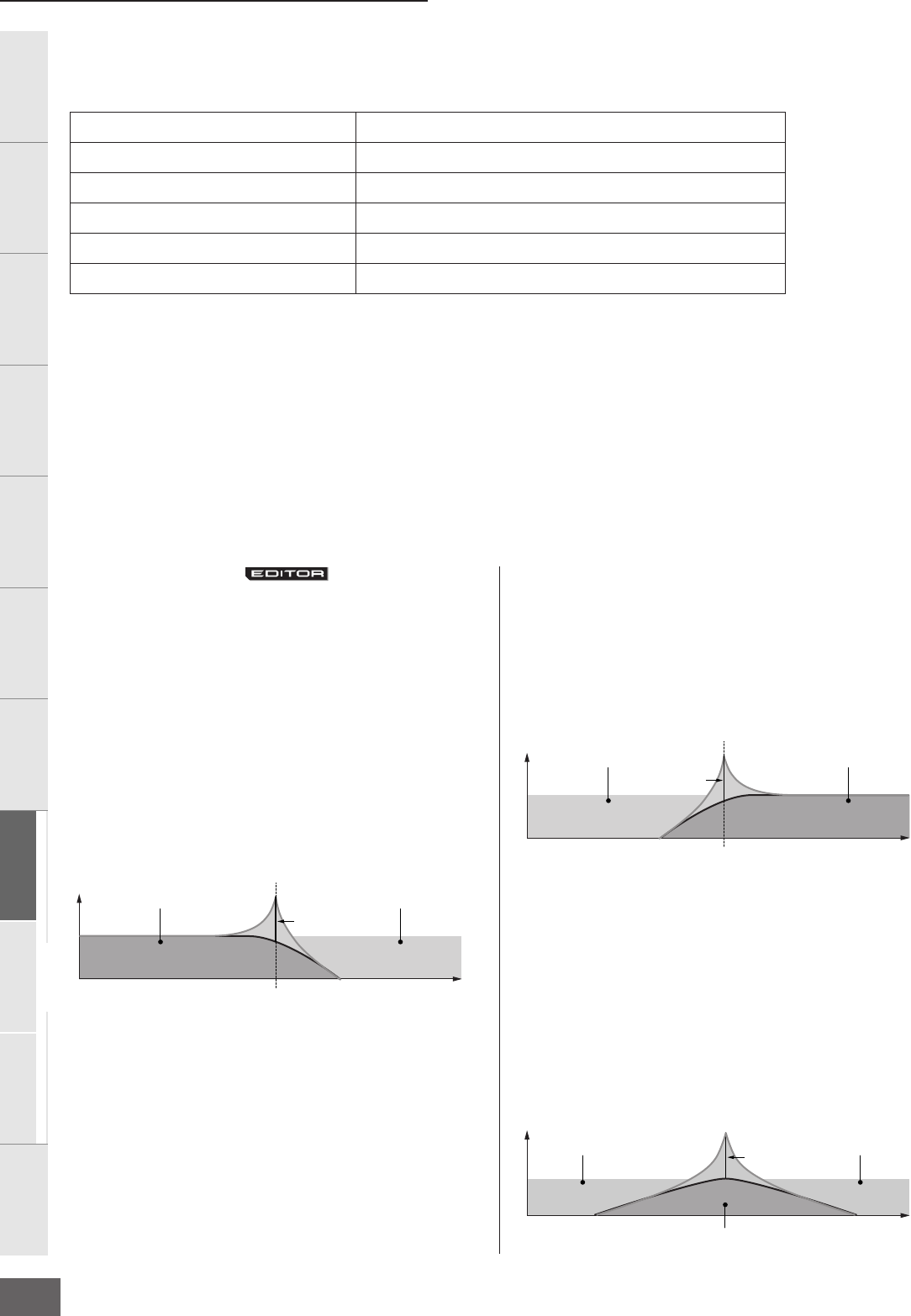
Voice Mode
MOTIF-RACK XS Owner’s Manual
88
Basic Structure
Reference
Voice
Multi Utility
The Controls &
Connectors
Setting Up
Listening to
the Sound
Connections
Using a Computer
Quick Guide
Appendix
Setting examples of the Destination
In this section, we’ll show you some useful examples how to set the “Ctrl Set 1 – 6 Dest (Controller Set Destination)” assignments
of the Control display in the Voice Common Edit parameters (page 71).
Concerning *1 – *4, the following settings are necessary in addition to the above setting.
*1
• Select the “LFO” in the Voice Edit Select display
➝
[ENTER]
➝
“Play Mode” = “loop”
• Select the “LFO” in the Voice Edit Select display
➝
[ENTER]
➝
“LFO Set 1 – 3 Dest” = “P mod”
*2
Controller Set in the Voice Common Edit on the MOTIF-RACK XS Editor
➝
“SW (Element Switch)” = “on”
*3
• Select the “Effect” in the Voice Common Select display
➝
[ENTER]
➝
select the “Ins A/B”
➝
[ENTER]
➝
“Type” = “Rotary Speaker”
• Effect in the Voice Common Edit on the MOTIF-RACK XS Editor
➝
“Element Out” / “Key Out” = ins A/B (assigned to “Rotary Speaker” type)
*4
• Select the “Effect” in the Voice Common Select display
➝
[ENTER]
➝
select the “Ins A/B”
➝
[ENTER]
➝
“Type” = “VCM Pedal Wah”
• Effect in the Voice Common Edit on the MOTIF-RACK XS Editor
➝
“Element Out” / “Key Out” = ins A/B (assigned to “VCM Pedal Wah”)
Filter Type List
In the sections that follow, we'll explain the Filter Type
specified in the Filter Type display of the Voice Element Edit.
LPF (Low Pass Filter)
This is a Filter type that only passes signals below the Cutoff
Frequency. The sound can be brightened by raising the
cutoff frequency of the filter. On the other hand, the sound
can be darkened by lowering the cutoff frequency of the
filter. You can then use Resonance to add further character
to the sound. This filter type is most popular and useful for
producing classic synthesizer sounds.
LPF24D
Compared to the LPF24A type (below), this filter can
produce a more pronounced resonance effect.
LPF24A
A digital dynamic low-pass filter with characteristics similar
to a 4-pole analog synthesizer filter.
LPF18
3-pole 18 dB/oct low-pass filter.
LPF18s
3-pole 18 dB/oct low-pass filter. This filter has a smoother
cutoff slope than the LPF18 type.
HPF (High Pass Filter)
This is a Filter type that only passes signals above the Cutoff
Frequency. You can then use the Resonance to add further
character to the sound.
HPF24D
A dynamic 24 dB/oct high-pass filter with a characteristic
digital sound. This filter can produce a pronounced
resonance effect.
HPF12
12 dB/oct dynamic high-pass filter.
BPF (Band Pass Filter)
This Filter type is a combination of a LPF and HPF. When this
Filter Type is selected, you can set the Cutoff Frequency
around which the audio signal is passed.
BPF12D
The combination of a -12 dB/oct HPF and LPF with a
characteristic digital sound.
To control the volume: Volume (volume)
To apply vibrato to the Voice: Common LFO Depth1 – 3 (C-LFO dpth1 – 3)
*1
To change the pitch: Element Pitch (coarse tune)
*2
To control the brightness of the Voice: Element Filter Frequency (cutoff)
*2
To change the speed of the Rotary Speaker: Insertion A/B Parameter 1 (ins A/B Rotor Slow)
*3
To apply wah pedal effect to the Voice: Insertion A/B Parameter 1 (ins A/B Pedal Ctrl)
*4
Level
These frequencies are
“passed” by the filter.
Resonance
Cutoff Frequency
Frequency
Cutoff range
Level
These frequencies are
“passed” by the filter.
Resonance
Cutoff Frequency
Frequency
Cutoff range
Level
Resonance
Frequency
Cutoff range
Cutoff range
Range passed


















